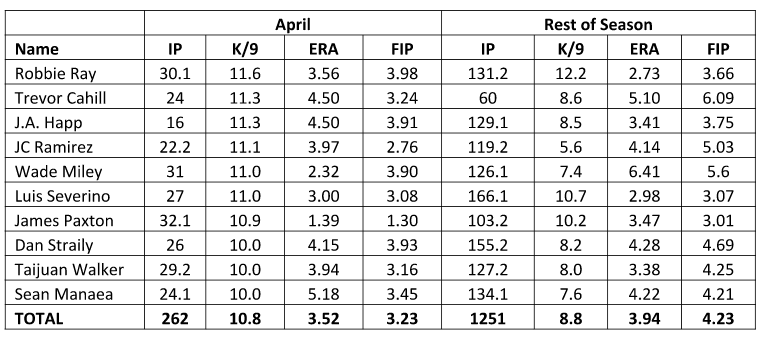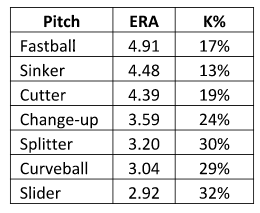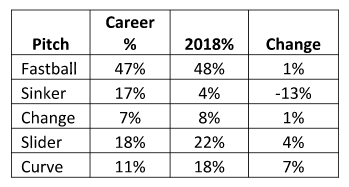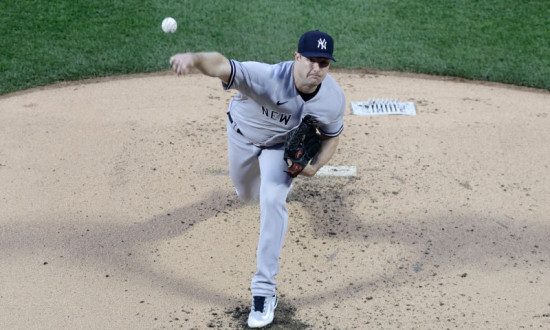2018 MLB Risers and Fallers: Volume 1
Welcome back to another season of Risers & Fallers! Last year in this space, I turned you onto first-half Alex Wood because of his increased velocity and incredible curveball pitch tunneling. I told you Justin Verlander would be fine. I told you Seth Lugo’s insane curveball spin rate didn’t make him a good pitcher and that Aaron Nola’s low swinging strike percentage didn’t matter.
This is where I dive deep into the numbers and the narratives and see what’s real and what isn’t using advanced metrics, my DFS projection system (THE BAT, available in the RotoGrinders Marketplace), and insights from my scouting background. I’ll examine guys whose stock is going up, guys whose stock is going down, guys who are perpetually underpriced or overpriced, guys who are worth paying a premium for, or guys who are just interesting and warrant some analysis on.
Rising… But (Probably) Not As Much As People Think
Gerrit Cole, SP, Houston Astros
Patrick Corbin, SP, Arizona Diamondbacks
Gerrit Cole and Patrick Corbin are off to insanely good starts to the 2018 season, and lots of people are buying in. It’s not all smoke and mirrors, either, because their peripherals are outstanding. Cole has a 15.4 K/9 and 1.57 xFIP while Corbin has a 12.1 K/9 and 1.78 xFIP.
Still, it would be easy to chalk most of this up to a small sample size and expect major regression. After all, both are approaching 30 years old and have never done anything remotely close to this in their careers. Regression is a normal thing, a fact of nature that we absolutely MUST expect of every extreme outlying performance, especially when the sample is this small. If you look at players who got off to similarly hot starts last year, almost all regressed heavily.
The following is a list of pitchers who posted a K/9 above 10.0 and a FIP below 4.00 in April 2017 and who did not post those marks in 2016 (i.e. Max Scherzer doesn’t count. He was good to begin with.)

While there were a couple exceptions, after their hot starts the cumulative K/9 went down by 2.0. ERA went up by 0.42. FIP went up by a full 1.00. Regression is real, and it should be expected to come for everyone. Always.
Of course, the EXTENT of the regression is another matter. I don’t think anyone is arguing that Gerrit Cole is a 15 K/9 pitcher. Nobody is that good. That’s insane. But what people are arguing is that Cole has made legitimate changes that make him a significantly better pitcher than what we saw of him in Pittsburgh.
There was a great article at FanGraphs recently called Patrick Corbin is McCullersing. Essentially, Lance McCullers has the best curveball in baseball, and instead of following the old baseball conventional wisdom of throwing your fastball the most and having your breaking ball play off it, McCullers throws his curveball 45% of the time. And because it is the best curveball in baseball, it makes him one of the best pitchers in baseball.
Corbin was FanGraphs’ poster boy for increasing breaking ball usage and decreasing fastball usage recently. Cole is doing the same thing. And there is little doubt that this should make them better pitchers. After all, breaking balls are better pitches than fastballs overall. Fastballs are necessary because part of what makes a breaking ball effective is that it plays off of a fastball. If a pitcher were to throw a breaking ball 100% of the time it would lose a lot of its effectiveness because it would be expected and hitters wouldn’t be fooled into thinking it looks like something else. I haven’t updated my pitcher “stuff” system since 2016 (it’s on my list to do over the next couple months and work into THE BAT), but these were the implied ERA and K% for each pitch type in 2016 for the average starting pitcher:

People think of fastballs as being great for strikeouts, especially with high velocity. They come in fast and blow right by the hitter. Except it doesn’t work that way. The off-speed pitches are FAR more effective both overall and in terms of strikeouts. So as long as a pitcher doesn’t take it to the extreme, shifting some usage off of fastballs and onto offspeed or breaking pitches should make a pitcher better. Viola, Gerrit Cole and Patrick Corbin are elite pitchers now!
Except, no. No. Not so fast. EXTENT matters. Extent is everything. Let’s look at how Cole has shifted his usage:

Essentially, he’s throwing 12% fewer sinkers and 12% more breaking balls. Because we know the average effectiveness of each pitch, we can quantify what kind of effect this would have on the average pitcher. I won’t bore you with the full math, but it’s easy enough to run yourself: replacing 12% sinkers with 12% breaking balls would roughly subtract 0.18 points of ERA and add 2.2% points to K%. That’s important, that’s significant, but that’s not “Gerrit Cole is the greatest pitcher in the universe” significant.

Okay, well, we know Cole isn’t an average pitcher. Maybe his breaking balls are better than average and his sinker is worse. In 2016 I had them projected with a normal split, but let’s say they’re different. Let’s say his sinker is a 5.00 ERA/10% K% pitch and his breaking balls are a combined 2.50 ERA/35% K%. That comes out to a 0.30 reduction in ERA and a 3.0% boost in K%. Again, good, but not mind-blowing.
It should be pretty obvious by now that altering pitch usage by just 12% imparts a certain cap on how much a pitcher can truly improve. In other words, while pitch usage absolutely matters and has made Cole better, it still only explains a fraction of what he is doing right now! The math just doesn’t add up any other way. And this is without accounting for any potential loss in effectiveness due to the pitch being more predictable.
To be clear, I’m not saying that Gerrit Cole isn’t a better pitcher than we expected him to be coming into the year. His projected ERA in THE BAT has improved by nearly 0.50 points. It has him as a borderline top 20 pitcher in baseball. THE BAT even likes him slightly more than Steamer and ZiPS do (you can view them side-by-side at FanGraphs). And THE BAT isn’t yet incorporating the change in pitch usage except to the extent it has affected his 2018 stats (this is something I am planning to add by mid-season), so it’s probably underrating him a bit. But based on the math we just ran, that would still probably only put him into the top 15 or so. I just don’t see how the change in pitch usage makes him a truly top, top tier pitcher.
That’s not to say he isn’t doing other things that could make him better than the projection systems think he is. The Astros are the smartest organization in baseball and are known for making their pitchers better. Maybe they’ve made his breaking balls better than they were in Pittsburgh. Maybe they’ve helped him with pitchability or sequencing or location or game-planning or any number of other things. Maybe he ramps his breaking ball usage up even farther going forward. But the argument people are using for Cole being an elite pitcher is based on the current change in usage, and that only explains a fraction of it.
Outliers do happen from time to time. We saw it last year with Paxton and Severino and Ray. When everyone else regressed, they went on to have stellar seasons. But they were the exception to the rule. If you want to pay for Cole hoping that he’s the exception, go right ahead. People want to believe what they’re seeing with their own eyes RIGHT NOW. How could what’s happening RIGHT NOW not be the truth? Baseball isn’t as neat as that, unfortunately. We have to expect regression, and we have to ask why and (more importantly) how much?
Yes, Gerrit Cole is very good. But based on the evidence we have right now, he’s not Corey Kluber. He’s not Max Scherzer. He’s not matchup-proof. And tonight’s matchup against the Mariners isn’t a particularly good one. It’s a park downgrade, it’s a good opposing offense, and it’s a low-strikeout opposing offense. Maybe he throws another 10 strikeouts anyway and continues proving the projection systems wrong, but after diving in, I just can’t justify playing him. In this matchup, you’d have to believe he’s Max Scherzer or Corey Kluber to justify it, and I just don’t see that being a reasonable estimate of his talent after three starts and a 12% change in pitch usage.